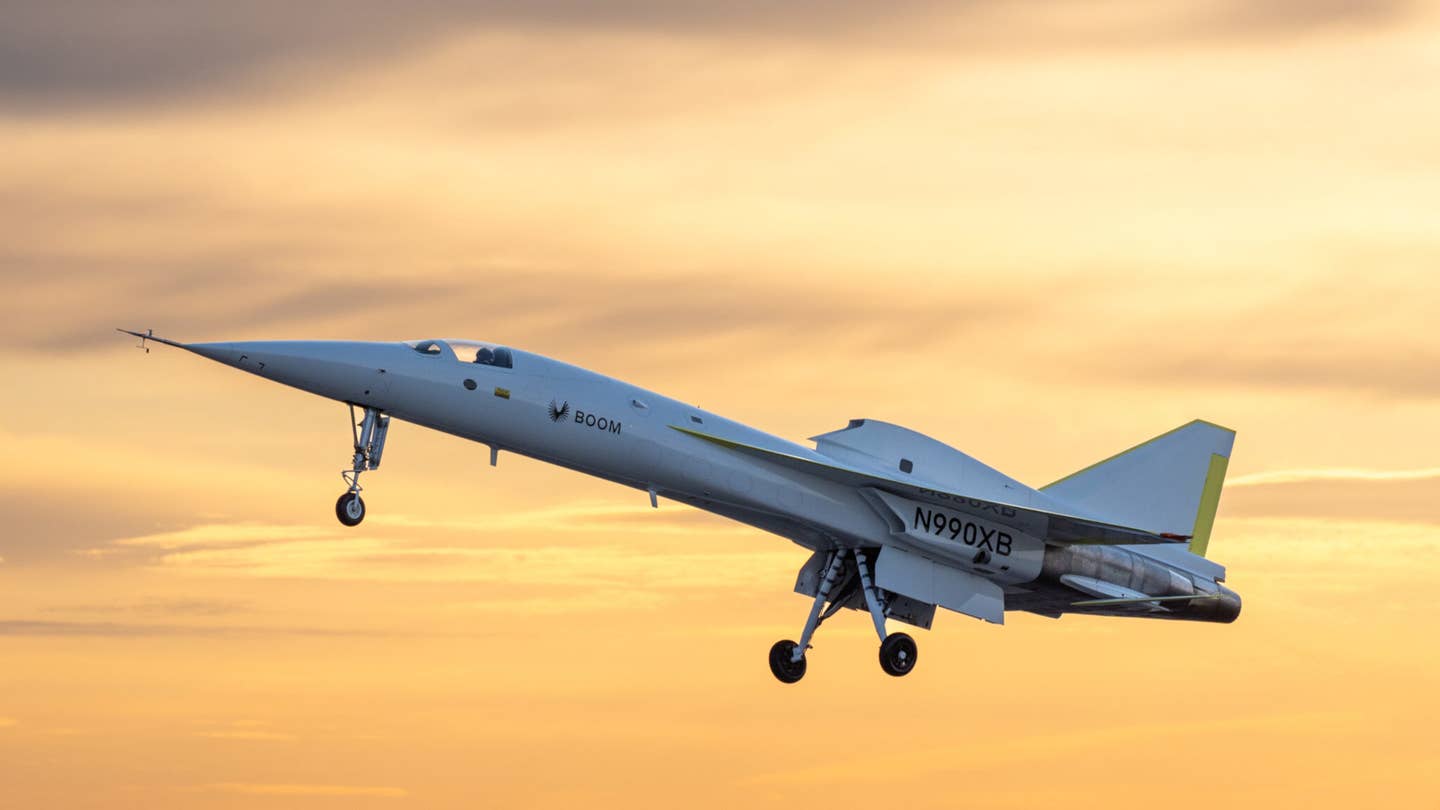Boom Supersonic Announces First Flight of XB-1 Jet Demonstrator
XB-1 flight testing and evaluations will inform development of Boom’s Overture, a supersonic jet designed to carry 64-80 passengers twice as fast as subsonic airliners.

Boom Supersonic’s XB-1 supersonic jet demonstrator takes off from the runway on its maiden flight on Friday, March 22. [Courtesy: Boom Supersonic]
More than two decades ago, Concorde, the only successful supersonic airliner, was retired for good. But Friday, at Mojave Air & Space Port (KMHV) in California—where the Bell X-1 broke the sound barrier for the first time in 1947—another supersonic aircraft made its maiden voyage.
Boom Supersonic’s XB-1 jet demonstrator did not reach supersonic speeds during the test flight. But the inaugural flight of the aircraft—a precursor to Boom’s supersonic, sustainable aviation fuel-powered Overture—marks a key milestone nonetheless.
“When I last flew Concorde in 2003, I knew that this day would come,” said Captain Mike Bannister, former chief Concorde pilot for British Airways. “The first flight of the XB-1 supersonic demonstrator is a significant achievement toward making sustainable supersonic flight a reality.”
The XB-1, which Boom says is the world’s first independently developed civil supersonic jet, combines carbon fiber composites, advanced avionics, digitally optimized aerodynamics, and an advanced supersonic propulsion system. These technologies will also be present on Overture, which is being developed to carry 64-80 at twice the speed of subsonic airliners.
The demonstrator is 62.6 feet long with a 21-foot wingspan. Its three GE J85-15 engines produce a combined max thrust of 12,300 pounds of force. Boom chief test pilot Bill “Doc” Shoemaker took it off the runway at Mojave Air & Space Port, flying in the same airspace that has hosted many historic first flights.
“I’ve been looking forward to this flight since founding Boom in 2014, and it marks the most significant milestone yet on our path to bring supersonic travel to passengers worldwide,” said Blake Scholl, founder and CEO of Boom Supersonic.
A T-38 chase aircraft monitored the XB-1 in the air, verifying factors such as altitude, airspeed, and airworthiness during flight. The company performed an initial assessment of the XB-1’s handling qualities, including airspeed checks with the chase aircraft, and assessed its stability in the landing attitude at a high angle of attack.
According to Boom, the aircraft met all of its test objectives. These included achieving an altitude of 7,120 feet and speeds up to 238 knots (273 mph).
The test flight is meant to validate the XB-1’s key technologies, such as an augmented reality vision system comprising two nose-mounted cameras that feed a high-resolution pilot display.
Another crucial component tested was the engine, which converts kinetic energy to pressure energy with supersonic intakes that slow supersonic air to subsonic speeds. Boom says this will allow conventional jet engines to power Overture from takeoff through supersonic flight.
The next step for the engineering team will be expanding the flight envelope for the XB-1. That will allow it to validate its performance and handling qualities through and beyond Mach 1, speeds Overture is expected to reach.
Boom intends for Overture to fly at Mach 1.7, or just over 1,300 mph. For comparison, Concorde flew at Mach 2. But unlike Concorde, Overture is designed to run on 100 percent SAF.
Leonardo is the engineering lead for the Overture’s fuselage structural components integration and will manufacture the aircraft’s composite structure. Other parts that will come from suppliers include wings designed by Aernnova, nacelles manufactured by Collins Aerospace, and Honeywell’s Anthem flight deck.
Scholl previously told The New York Times that the company’s goal is to fly passengers anywhere in the world within four hours—for only $100. That’s inexpensive compared to most one-way commercial flights, let alone Concorde, which cost passengers thousands of dollars.
However, don’t worry about supersonic booms over your backyard. Overture will only fly supersonic on overwater routes, since the FAA has banned it over the continental U.S.
Boom’s order backlog for Overture includes 130 orders and preorders, including 15 aircraft for American Airlines and 20 apiece for United Airlines and Japan Airlines.
The manufacturer’s $60 million U.S. Air Force contract should help speed development of the aircraft, giving it a potential customer as well. Boom is also partnered with Northrop Grumman to design a special mission variant of Overture for potential U.S. military operations, disaster response, and high-speed surveillance.
Like this story? We think you'll also like the Future of FLYING newsletter sent every Thursday afternoon. Sign up now.

Subscribe to Our Newsletter
Get the latest FLYING stories delivered directly to your inbox






